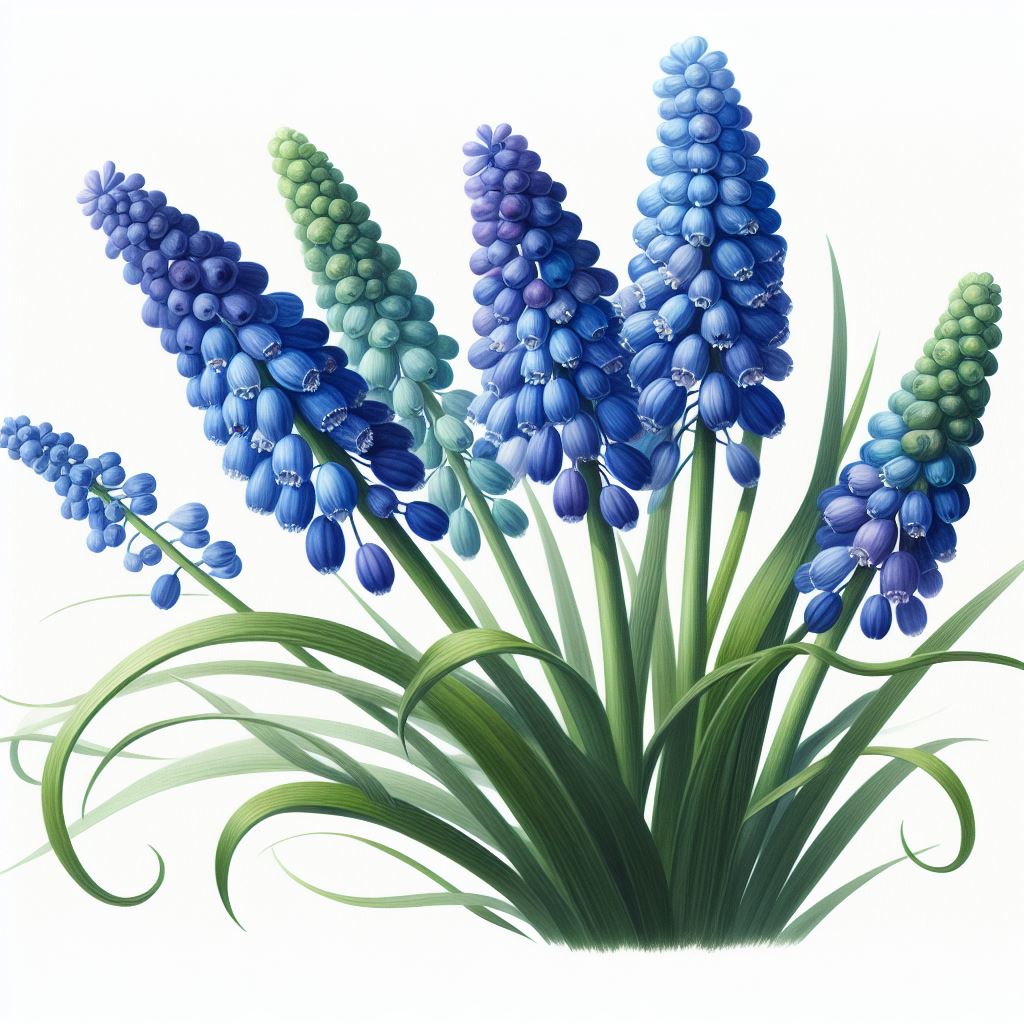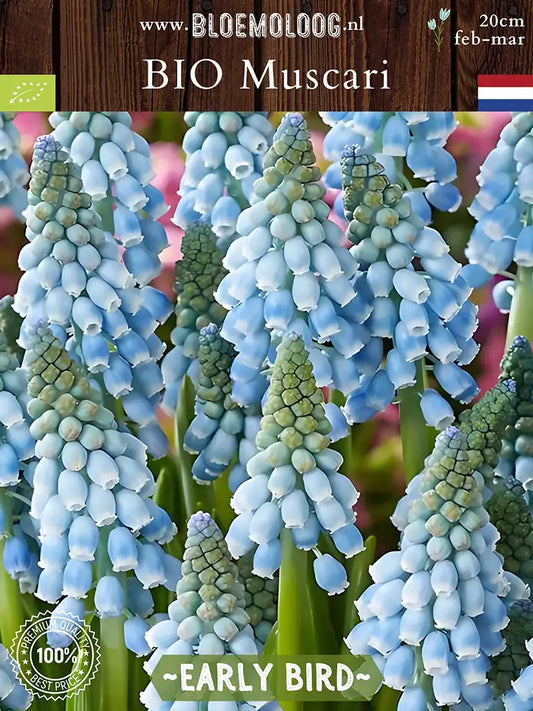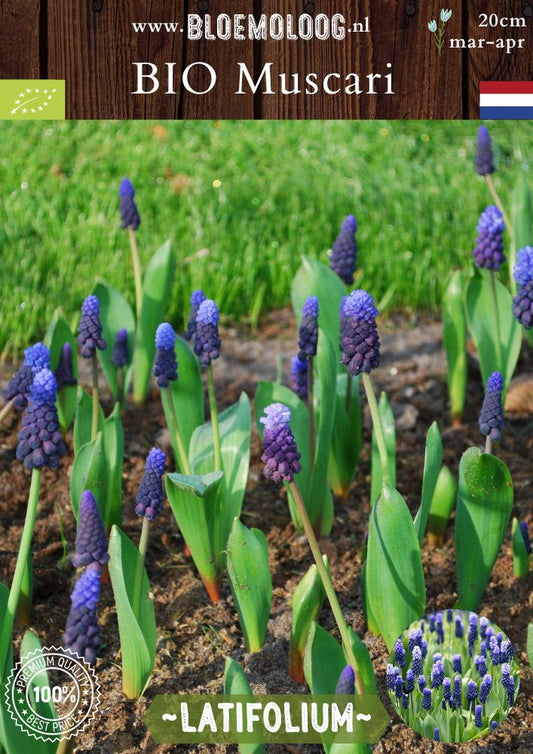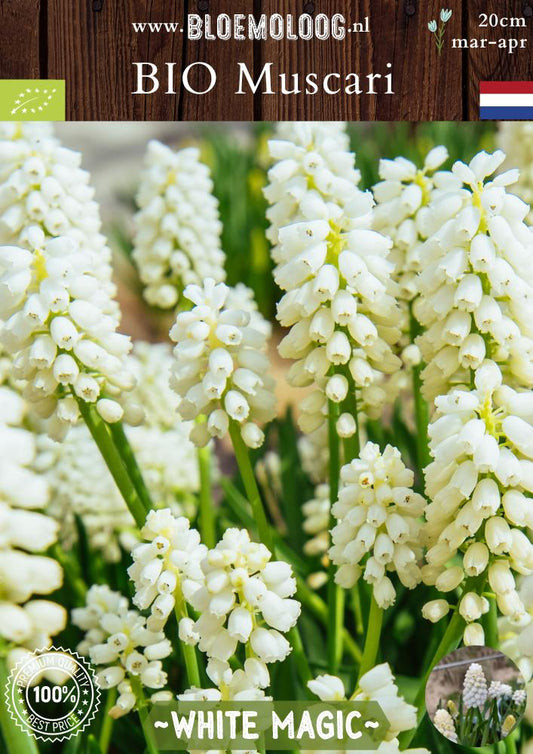
Collection: Organic muscari
Organic grape hyacinths
Muscari , also known as grape hyacinths, are popular for their blue, purple or white flower clusters in a conical shape, which resemble bunches of grapes, hence the name "grape hyacinths".
The flower clusters bloom on top of flower stems of about 20 centimeters high. They bloom in March and April with 3 to 5 flower stems per bulb and produce 3 to 5 bluish green narrow leaves per bulb, which are higher than the flower.
By grape hyacinths we mean the well-known blue Grape hyacinth and the white grape hyacinths, but less known are the double-flowered grape hyacinth, which produce thick bunches of flowers and are also very decorative.
Muscari for bees
The flowers of grape hyacinths contain a lot of nectar, which provides pollinators such as bees with a lot of nutrition so early in the year.
Where do I plant muscari flowerbulbs?
The muscari flowerbulbs need a cold period and should be planted in the ground from September to January. The correct planting depth varies between 2 to 3 times the height of the flowerbulb itself and the planting distance is also 2 to 3 times the width of the flowerbulb itself.
Plant the flowerbulbs in a nutrient-rich, water-drained soil, preferably a calcareous sandy soil. They also grow in clay soil, as long as the soil is well-drained and does not retain excess water. If you have clay soil, you can improve the soil by adding organic matter such as compost or well-rotted manure to improve drainage.
Plant muscari in a sunny to semi-shaded position or under deciduous trees where the sun shines in winter, but is sheltered under the trees in summer.
Care of the muscari
Provide organic nutrients when planting and just before flowering. After flowering, the dead flowers at the top of the flower stem are cut off and the foliage dies off automatically. Only cut the foliage when it has completely died. The muscari is a real Stinzen plant. It naturalizes easily if planted in the right location. Provide organic food annually for optimal results.
Propagation
The muscari reproduces via seed and produces many small breeding balls every year. For propagation, the flowerbulbs are removed from the ground at the beginning of summer, divided and immediately planted again. The seed can also be grown in the winter in a pot with compost, covered with a thin layer of grit. Cover the jar with plastic or glass for moisture retention. As soon as the shoots are above the ground, the pot can go outside.
Origin of the muscari
The muscari belong to the asparagus family (Asparagaceae). They originally occur in areas from Turkey to the Caucasus Mountains, but have been growing in the wild in the Netherlands for centuries.
Buy Muscari
At the Bloemoloog, muscari flowerbulbs are available in the webshop from June to January and on the market from August to January.
-
Organic Muscari 'Early Bird' | 10+10 pcs.
Regular price €5,35Regular priceUnit price €0,54 each€10,70Sale price €5,35Sale -
Organic Muscari 'Latifolium' - Grape hyacinths | 10+10 pcs.
Regular price €4,50Regular priceUnit price €0,45 each€9,00Sale price €4,50Sale -
Organic Muscari 'White Magic' - White grape hyacinth | 10 pcs.
Regular price €3,95Regular priceUnit price €0,40 each -
Organic Muscari 'Armeniacum' - Grape hyacinth | 10 pcs.
Regular price €3,95Regular priceUnit price €0,40 each -
Organic Narcissus 'Tête-à-Tête' & Muscari 'Armeniacum' mix | 20 pcs.
Regular price €9,95Regular price
-
Organic spring bulbs
Spring-flowering bulbs and tubers are popular plants that produce beautiful flowers from early spring through summer. Because of their early bloom, they combine well with perennials when they still need to establish themselves.
Tulips are probably the most well-known spring flowers. They come in many different colors, shapes, and sizes. Daffodils are known for their cheerful yellow flowers, but they also come in other colors like white and orange. Crocuses are small bulbous plants with striking flowers in shades of purple, yellow, and white. They are often the first flowers to appear in spring. Hyacinths have fragrant flowers in various colors, such as pink, purple, blue, and white. They are often planted in borders, flower beds, or pots.Benefits of organic spring bulbs
When you choose organic flower bulbs that bloom in spring, you can be sure that no chemicals or pesticides will end up in your garden. These pesticides are harmful to bees and prevent them from finding their nests. As a result, more and more bee species have been added to the red list in recent years. Together, we can do something about this!
Flower bulbs for wild bees
Did you know that wild bees lay eggs in their nests, which then hatch in early spring? These newborn insect helpers immediately search for food in the surrounding area. There are also insects that have hibernated and are desperately looking for a hearty breakfast: the blooming flowers where nectar and pollen can be found! Just after winter, there's little greenery or food for these insects. Planting early-blooming flower bulbs ensures there's food available, and the insects can gain strength for the coming summer.
Organic growers
The organic growers we work with cultivate not only the most beautiful but also the strongest products. They cultivate varieties and species of flowers and plants that experience has shown to be virus-resistant, so they don't need to use chemicals and pesticides. Organic growers seek natural remedies and solutions against diseases and/or pests. All our flower bulbs are certified organic; both the Florist and the growers are SKAL-certified.
When do you plant spring bulbs?
Spring-flowering bulbs can be planted from autumn until January. Bulbs that need to be dug up in the summer after flowering should be dug up starting in late July and stored until the next planting season in autumn.
What to do after flowering
When spring bloomers have finished blooming, cut off the wilted flowers at the top of the stem. Let the rest of the plant die back naturally so it can still receive maximum energy from the sun.
How do you store spring bulbs?
If you've purchased flower bulbs from us and had them delivered to your home and would like to leave them for a while, we recommend opening the box and storing it in a ventilated, cool place until you're ready to plant them.
Store flower bulbs you dig up after flowering in a warm place, such as a shed. To prevent mice from eating the bulbs during this period, you can also hang them in a bag or pantyhose. -
Where is the best place to plant spring bulbs?
Spring-flowering bulbs are flowers that bloom in the spring, between January and July. There are many different types of spring-flowering bulbs, suitable for different types of gardens and soil. For example, some bulb plants enjoy catching a glimpse of the sun during flowering, but prefer to be covered by a tree during their dormant period in summer.
Spring bloomers in the sun
Many spring bloomers need plenty of sun to bloom and grow well for the following year. These flowers thrive in full sun:
Spring bloomers in the shade
Some spring bloomers also grow and bloom well in the shade, such as:
Spring bloomers in moist soil types
There are also flower bulbs that can be planted in moist soil. Some varieties from the Florist's collection include:
Conclusion
There are many different types of spring bloomers suitable for different types of gardens and soil. Whether a spring bloomer can grow in sun or shade depends on the specific variety. Some prefer dry soil, while others prefer wet feet. So, there's a suitable spring bloomer for every garden.
Tips for a flowery garden
Plant a variety of flowers, each with its own blooming time, so there are flowers blooming throughout the spring and food for bees and other insects in your garden. Would you also like to arrange your garden/bed so you can enjoy flowers all spring long, and the bees too? Feel free to send us a message or ask us at the market stall. We're happy to help! Promote biodiversity in your garden and enjoy the first flowers and colors after the cold and dark winter!
Order spring bloomers in advance
Pre-sales for spring-flowering bulbs will begin on June 1st in the Bloemoloog webshop.
During the pre-sale, you can pre-order your desired products. This way, you can be sure your favorite flowers are still in stock, and we'll ship your package with PostNL as soon as planting time arrives.
Flower bulbs ordered in the pre-sale will be delivered in mid-September. From then on, they can be planted directly in the garden or in containers on the balcony.








